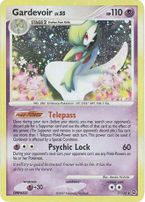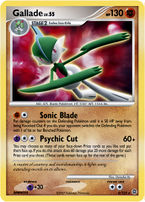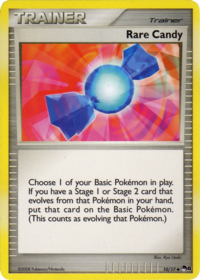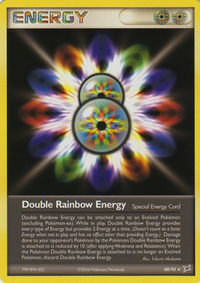Gardevoir/Gallade (TCG): Difference between revisions
Politoed666 (talk | contribs) mNo edit summary |
Mr. Daikon (talk | contribs) m (More relevant in the modern day) |
||
| (16 intermediate revisions by 12 users not shown) | |||
| Line 1: | Line 1: | ||
'''''GG''' redirects here. This can also refer to a casual abbreviation for "good game" considered polite after an online battle on a simulator such as [[ | '''''GG''' redirects here. This can also refer to a casual abbreviation for "good game" considered polite after an online battle on a simulator such as [[Pokémon Showdown]].'' | ||
---- | ---- | ||
{{ArchetypeInfobox | {{ArchetypeInfobox | ||
| Line 10: | Line 10: | ||
|era=2007-2009 | |era=2007-2009 | ||
}} | }} | ||
'''Gardevoir/Gallade''', with more {{TCG ID|Secret Wonders|Gardevoir|7}}-centric variations known as '''PLOX''' (short for ''Power Lock'' or ''Psychic Lock''), is considered by many to be the most dominant {{TCG|deck archetype}} of its era. After the release of the {{TCG|Secret Wonders}} expansion, players built on the obvious synergy between Gardevoir and {{TCG ID|Secret Wonders|Gallade|6}} to create early variants of the deck, which performed well in | '''Gardevoir/Gallade''', with more {{TCG ID|Secret Wonders|Gardevoir|7}}-centric variations known as '''PLOX''' (short for ''Power Lock'' or ''Psychic Lock''), is considered by many to be the most dominant {{TCG|deck archetype}} of its era. After the release of the {{TCG|Secret Wonders}} expansion, players built on the obvious synergy between Gardevoir and {{TCG ID|Secret Wonders|Gallade|6}} to create early variants of the deck, which performed well in [[Play! Pokémon]] tournaments. Dominating the competitive play scene, Gardevoir/Gallade went on to win the {{TCG|2008 World Championships}}, played by two-time World Champion [[Jason Klaczynski]]. His variant, packaged as a [[Theme Deck (TCG)#2008 World Championships|world championships deck]], is known officially as ''{{TCG|Psychic Lock}}''. Later versions of the deck used {{TCG ID|Secret Wonders|Weavile|40}} as a means of energy acceleration, although they never performed as well as early versions of Gardevoir/Gallade. | ||
==Strategy== | ==Strategy== | ||
[[File:RareCandy10POPSeries8.png|thumb|left|{{TCG|Rare Candy}}]] | [[File:RareCandy10POPSeries8.png|thumb|left|200px|{{TCG|Rare Candy}}]] | ||
Gardevoir/Gallade focused on preventing the opponent from using {{TCG|Poké-Power}}s through the use of {{TCG ID|Secret Wonders|Gardevoir|7}}'s ''Psychic Lock'' attack and easily knocking out the opponents' heavy attackers with {{TCG ID|Secret Wonders|Gallade|6}}'s ''Psychic Cut''. Through the use of ''Telepass'' and ''Cosmic Power'', Gardevoir and {{TCG ID|Great Encounters|Claydol|15}}'s respective Poké-Powers, in combination with a variety of searching and drawing {{TCG|Supporter card}}s such as {{TCG|Roseanne's Research}} and {{TCG|Celio's Network}}, Gardevoir/Gallade easily set up. | Gardevoir/Gallade focused on preventing the opponent from using {{TCG|Poké-Power}}s through the use of {{TCG ID|Secret Wonders|Gardevoir|7}}'s ''Psychic Lock'' attack and easily knocking out the opponents' heavy attackers with {{TCG ID|Secret Wonders|Gallade|6}}'s ''Psychic Cut''. Through the use of ''Telepass'' and ''Cosmic Power'', Gardevoir and {{TCG ID|Great Encounters|Claydol|15}}'s respective Poké-Powers, in combination with a variety of searching and drawing {{TCG|Supporter card}}s such as {{TCG|Roseanne's Research}} and {{TCG|Celio's Network}}, Gardevoir/Gallade easily set up. | ||
The deck's remarkable consistency left room for a number of situational cards. This build uses {{TCG ID|Diamond & Pearl|Dusknoir|2}} as a tech against the many archetypes of the time that filled the | The deck's remarkable consistency left room for a number of situational cards. This build uses {{TCG ID|Diamond & Pearl|Dusknoir|2}} as a tech against the many archetypes of the time that filled the Bench with important Pokémon. {{TCG ID|Secret Wonders|Gardevoir LV.X|131}} was used as a tertiary attacker to clean up heavily damaged Pokémon on the opponent's Bench. Cards such as {{TCG|Battle Frontier}} and {{TCG|Crystal Shard}} were helpful against certain matchups, such as {{TCG|Infercatty}} and {{TCG|Skittles}}, respectively. | ||
==Key Cards== | ==Key Cards== | ||
* '''{{TCG ID|Secret Wonders|Gardevoir|7}}''' - Gardevoir was a secondary attacker in more offensive builds and the main attacker in PLOX. | * '''{{TCG ID|Secret Wonders|Gardevoir|7}}''' - Gardevoir was a secondary attacker in more offensive builds and the main attacker in PLOX. Its ''Telepass'' Poké-Power was useful in setting up, allowing the Gardevoir/Gallade player to utilize the effect of an opponent's {{TCG|Supporter card}} in their discard pile. Gardevoir's attack, ''Psychic Lock'', did 60 damage for {{e|Psychic}}{{e}}{{e}} and prevented the opponent from using Poké-Powers during their next turn. In an era where many decks relied on Poké-Powers such as {{TCG ID|Great Encounters|Claydol|15}}'s ''Cosmic Power'' to set up, this was a powerful disruption effect that could shut the opponent down early in the game. | ||
* '''{{TCG ID|Secret Wonders|Gallade|6}}''' - Gallade had the ability to knock out almost any Pokémon in the game in one shot for only {{e|Psychic}}{{e}}{{e}} with ''Psychic Cut''. It required the player to flip over any amount of | * '''{{TCG ID|Secret Wonders|Gallade|6}}''' - Gallade had the ability to knock out almost any Pokémon in the game in one shot for only {{e|Psychic}}{{e}}{{e}} with ''Psychic Cut''. It required the player to flip over any amount of their prize cards, and did 60 damage plus 20 more damage for each prize card flipped. This allowed Gallade to hit for up to 180 damage once, 100 damage three times, 80 damage six times, and so on. Against decks that built up one main attacker and attempted to keep it alive, Gallade's ability to OHKO virtually anything was a tremendous threat. In its day, ''Psychic Cut'' was an incredible attack. Gallade also possessed ''Sonic Blade'' which, for {{e|Fighting}}{{e}}, put damage counters on the Defending Pokémon until it was 50 HP away from being knocked out. It also forced the opponent to switch it with one of their Benched Pokémon. ''Sonic Blade'' could set up even the bulkiest of Defending Pokémon for a KO the next turn with ''Psychic Cut'' or {{TCG ID|Secret Wonders|Gardevoir LV.X|131}}'s ''Bring Down''. | ||
* '''{{TCG ID|Great Encounters|Claydol|15}}''' - While Gardevoir's ''Telepass'' could utilize searching Supporter cards in the opponent's discard pile, Claydol provided Gardevoir/Gallade's main drawpower. | * '''{{TCG ID|Great Encounters|Claydol|15}}''' - While Gardevoir's ''Telepass'' could utilize searching Supporter cards in the opponent's discard pile, Claydol provided Gardevoir/Gallade's main drawpower. Claydol's ''Cosmic Power'' simply sped up the deck's ability to get an attacker up and running. | ||
[[File: | [[File:DoubleRainbowEnergyEXTeamMagmavsTeamAqua88.jpg|thumb|right|200px|{{TCG|Double Rainbow Energy}}]] | ||
* '''{{TCG|Rare Candy}}''' - Since Gardevoir and Gallade were both Stage 2 evolved Pokémon, Rare Candy's ability to skip the {{TCG ID|Secret Wonders|Kirlia|53}} stage of evolution was an important asset to Gardevoir/Gallade's quick setup. | * '''{{TCG|Rare Candy}}''' - Since Gardevoir and Gallade were both Stage 2 evolved Pokémon, Rare Candy's ability to skip the {{TCG ID|Secret Wonders|Kirlia|53}} stage of evolution was an important asset to Gardevoir/Gallade's quick setup. | ||
* '''{{TCG|Windstorm}}''' - Three Windstorm were critical to the deck to counter {{TCG|Cessation Crystal}}, | * '''{{TCG|Windstorm}}''' - Three Windstorm were critical to the deck to counter {{TCG|Cessation Crystal}}, which nullified both ''Telepass'' and ''Cosmic Power'', and, most importantly, {{TCG|Crystal Beach}}. Crystal Beach was considered by many to be the most powerful card against Gardevoir/Gallade. It made all [[List of Special Energy cards|Special Energies]] that provided two or more units of Energy now provide only {{e}}. Since Gardevoir/Gallade essentially relied on {{TCG|Double Rainbow Energy}} and {{TCG|Scramble Energy}} to satisfy the energy costs of its attackers, Crystal Beach ripped apart its strategy. Windstorm's ability to discard Crystal Beach was absolutely vital. | ||
* '''{{TCG|Double Rainbow Energy}}''' - Double Rainbow Energy was the card most often used to power Gardevoir and Gallade's respective attacks. Although it slightly decreased the amount of damage the Pokémon could do, the ability to essentially have two energy attachments in a single turn allowed the deck to begin attacking significantly faster and recover from knocked out attackers quickly. | * '''{{TCG|Double Rainbow Energy}}''' - Double Rainbow Energy was the card most often used to power Gardevoir and Gallade's respective attacks. Although it slightly decreased the amount of damage the Pokémon could do, the ability to essentially have two energy attachments in a single turn allowed the deck to begin attacking significantly faster and recover from knocked out attackers quickly. | ||
* '''{{TCG|Scramble Energy}}''' - Scramble Energy served essentially as a more powerful Double Rainbow Energy, but functioned only when the Gardevoir/Gallade player was behind in prizes. Scramble Energy assured that the deck was never down, allowing a Gallade's ''Psychic Cut'' to be fully powered up with only one energy attachment. | * '''{{TCG|Scramble Energy}}''' - Scramble Energy served essentially as a more powerful Double Rainbow Energy, but functioned only when the Gardevoir/Gallade player was behind in prizes. Scramble Energy assured that the deck was never down, allowing a Gallade's ''Psychic Cut'' to be fully powered up with only one energy attachment. | ||
==Typical decklist== | ==Typical decklist== | ||
{{DeckArchetype}} | {{DeckArchetype|an {{TCG|EX Holon Phantoms}} through {{TCG|Majestic Dawn}}}} | ||
{{decklist/header}} | {{decklist/header}} | ||
{{decklist/entry|1|{{TCG ID|Secret Wonders|Gardevoir LV.X|131}}|Psychic||Rare Holo LV.X}} | {{decklist/entry|1|{{TCG ID|Secret Wonders|Gardevoir LV.X|131}}|Psychic||Rare Holo LV.X}} | ||
| Line 48: | Line 48: | ||
{{decklist/entry|2|{{TCG|TV Reporter}}|Supporter||Uncommon}} | {{decklist/entry|2|{{TCG|TV Reporter}}|Supporter||Uncommon}} | ||
{{decklist/entry|4|{{TCG|Rare Candy}}|Trainer||Uncommon}} | {{decklist/entry|4|{{TCG|Rare Candy}}|Trainer||Uncommon}} | ||
{{decklist/entry|3|{{TCG|Windstorm}}|Trainer||Uncommon}} | {{decklist/entry|3|{{TCG ID|EX Crystal Guardians|Windstorm|85}}|Trainer||Uncommon}} | ||
{{decklist/entry|1|{{TCG|Crystal Shard}}|Trainer||Uncommon}} | {{decklist/entry|1|{{TCG|Crystal Shard}}|Trainer||Uncommon}} | ||
{{decklist/entry|2|{{TCG|Dusk Ball}}|Trainer||Uncommon}} | {{decklist/entry|2|{{TCG|Dusk Ball}}|Trainer||Uncommon}} | ||
| Line 55: | Line 55: | ||
{{decklist/entry|4|{{TCG|Double Rainbow Energy}}|Energy|Colorless|Rare}} | {{decklist/entry|4|{{TCG|Double Rainbow Energy}}|Energy|Colorless|Rare}} | ||
{{decklist/entry|3|{{TCG|Scramble Energy}}|Energy|Colorless|Uncommon}} | {{decklist/entry|3|{{TCG|Scramble Energy}}|Energy|Colorless|Uncommon}} | ||
{{decklist/entry|4|{{TCG|Psychic Energy}}|Energy|Psychic| | {{decklist/entry|4|{{TCG|Psychic Energy}}|Energy|Psychic|None}} | ||
{{decklist/entry|3|{{TCG|Fighting Energy}}|Energy|Fighting| | {{decklist/entry|3|{{TCG|Fighting Energy}}|Energy|Fighting|None}} | ||
{{decklist/footer}} | {{decklist/footer}} | ||
==Possible Tech Cards== | ==Possible Tech Cards== | ||
[[File:WeavileSecretWonders40.jpg|thumb|left|{{TCG ID|Secret Wonders|Weavile|40}}]] | [[File:WeavileSecretWonders40.jpg|thumb|left|200px|{{TCG ID|Secret Wonders|Weavile|40}}]] | ||
* '''{{TCG ID|EX Crystal Guardians|Jirachi ex|94}}''' - Jirachi ex | * '''{{TCG ID|EX Crystal Guardians|Jirachi ex|94}}''' - Jirachi ex was generally used in variants that focused more on locking the opponent's Poké-Powers than taking prizes quickly. Jirachi ex's ''Shield Beam'' attack, which cost only {{e|Psychic}} when the opponent had any Stage-2 evolved Pokémon or {{TCG|Pokémon-ex}} in play, did 30 damage and prevented the opponent from using any Poké-Powers during their next turn. Jirachi ex was essentially a faster but less powerful version of {{TCG ID|Secret Wonders|Gardevoir|7}} to be used when the latter was not available. | ||
* '''[[Jolteon ☆ (EX Power Keepers 101)|Jolteon]]''' {{Star}} - Although it | * '''[[Jolteon ☆ (EX Power Keepers 101)|Jolteon]]''' {{Star}} - Although it was not an especially common tech card, [[Jason Klaczynski]] used Jolteon {{Star}} in Gardevoir/Gallade to help the deck knock out Pokémon with an odd-number of HP in one shot. Since {{TCG ID|Secret Wonders|Gallade|6}}'s ''Psychic Cut'' attack did damage in multiples of 20, it needed to flip over three prize cards to knock out a Defending Pokémon with 120 HP, but four to knock out a Pokémon with 130 HP. Jolteon {{Star}}'s ''Yellow Ray'' Poké-Power allowed Gallade to knock out Pokémon with odd HP by flipping over one less prize. | ||
* '''{{TCG ID|Majestic Dawn|Chatot|55}}''' - Chatot was used as a hand refresher and free retreater. | * '''{{TCG ID|Majestic Dawn|Chatot|55}}''' - Chatot was used as a hand refresher and free retreater. Chatot's ''Mimic'' attack allowed the Gardevoir/Gallade player to shuffle their hand into her deck and draw the same number of cards. ''Mimic'', in combination with its free retreat, made Chatot a fantastic remedy to a poor starting hand. | ||
* '''{{TCG ID|Secret Wonders|Weavile|40}}''' - After the rotation of {{TCG|Double Rainbow Energy}} and {{TCG|Scramble Energy}}, Gardevoir/Gallade suffered from a lack of energy acceleration and faded from the public eye. However, players began to combo the deck's main attackers with Weavile, [[Darkness Energy (Special)|Special Darkness Energies]], and a newer line of {{TCG|Trainer card|Trainers}}, {{TCG|Supporter card|Supporters}}, and {{TCG|Stadium card|Stadiums}}. | * '''{{TCG ID|Secret Wonders|Weavile|40}}''' - After the rotation of {{TCG|Double Rainbow Energy}} and {{TCG|Scramble Energy}}, Gardevoir/Gallade suffered from a lack of energy acceleration and faded from the public eye. However, players began to combo the deck's main attackers with Weavile, [[Darkness Energy (Special)|Special Darkness Energies]], and a newer line of {{TCG|Trainer card|Trainers}}, {{TCG|Supporter card|Supporters}}, and {{TCG|Stadium card|Stadiums}}. Weavile's ''Shadow Charge'' attack allowed for faster energy attachment to Gardevoir and Gallade, and its ''Dark Engage'' Poké-Power allowed attackers to do more damage when they had Special Darkness Energies attached. Weavile was not so much a tech card as the revival of Gardevoir/Gallade. | ||
==External links== | |||
* [http://www.pojo.com/CardofTheDay/2008/8-22.shtml Jason Klaczynski's 2008 Worlds Report] | |||
* [http://www.pojo.com/pokemon/FeaturedWriters/monster/2010/8-31.shtml Analysis of Gardevoir decks from 2008 to 2010] | |||
{{Project TCG notice}} | {{Project TCG notice}} | ||
[[Category:Deck archetypes]] | [[Category:Deck archetypes]] | ||
Latest revision as of 00:36, 4 March 2020
GG redirects here. This can also refer to a casual abbreviation for "good game" considered polite after an online battle on a simulator such as Pokémon Showdown.
| Gardevoir/Gallade | ||||||||||
|---|---|---|---|---|---|---|---|---|---|---|
| ||||||||||
Gardevoir/Gallade, with more Gardevoir-centric variations known as PLOX (short for Power Lock or Psychic Lock), is considered by many to be the most dominant deck archetype of its era. After the release of the Secret Wonders expansion, players built on the obvious synergy between Gardevoir and Gallade to create early variants of the deck, which performed well in Play! Pokémon tournaments. Dominating the competitive play scene, Gardevoir/Gallade went on to win the 2008 World Championships, played by two-time World Champion Jason Klaczynski. His variant, packaged as a world championships deck, is known officially as Psychic Lock. Later versions of the deck used Weavile as a means of energy acceleration, although they never performed as well as early versions of Gardevoir/Gallade.
Strategy
Gardevoir/Gallade focused on preventing the opponent from using Poké-Powers through the use of Gardevoir's Psychic Lock attack and easily knocking out the opponents' heavy attackers with Gallade's Psychic Cut. Through the use of Telepass and Cosmic Power, Gardevoir and Claydol's respective Poké-Powers, in combination with a variety of searching and drawing Supporter cards such as Roseanne's Research and Celio's Network, Gardevoir/Gallade easily set up.
The deck's remarkable consistency left room for a number of situational cards. This build uses Dusknoir as a tech against the many archetypes of the time that filled the Bench with important Pokémon. Gardevoir LV.X was used as a tertiary attacker to clean up heavily damaged Pokémon on the opponent's Bench. Cards such as Battle Frontier and Crystal Shard were helpful against certain matchups, such as Infercatty and Skittles, respectively.
Key Cards
- Gardevoir - Gardevoir was a secondary attacker in more offensive builds and the main attacker in PLOX. Its Telepass Poké-Power was useful in setting up, allowing the Gardevoir/Gallade player to utilize the effect of an opponent's Supporter card in their discard pile. Gardevoir's attack, Psychic Lock, did 60 damage for


 and prevented the opponent from using Poké-Powers during their next turn. In an era where many decks relied on Poké-Powers such as Claydol's Cosmic Power to set up, this was a powerful disruption effect that could shut the opponent down early in the game.
and prevented the opponent from using Poké-Powers during their next turn. In an era where many decks relied on Poké-Powers such as Claydol's Cosmic Power to set up, this was a powerful disruption effect that could shut the opponent down early in the game. - Gallade - Gallade had the ability to knock out almost any Pokémon in the game in one shot for only


 with Psychic Cut. It required the player to flip over any amount of their prize cards, and did 60 damage plus 20 more damage for each prize card flipped. This allowed Gallade to hit for up to 180 damage once, 100 damage three times, 80 damage six times, and so on. Against decks that built up one main attacker and attempted to keep it alive, Gallade's ability to OHKO virtually anything was a tremendous threat. In its day, Psychic Cut was an incredible attack. Gallade also possessed Sonic Blade which, for
with Psychic Cut. It required the player to flip over any amount of their prize cards, and did 60 damage plus 20 more damage for each prize card flipped. This allowed Gallade to hit for up to 180 damage once, 100 damage three times, 80 damage six times, and so on. Against decks that built up one main attacker and attempted to keep it alive, Gallade's ability to OHKO virtually anything was a tremendous threat. In its day, Psychic Cut was an incredible attack. Gallade also possessed Sonic Blade which, for 
 , put damage counters on the Defending Pokémon until it was 50 HP away from being knocked out. It also forced the opponent to switch it with one of their Benched Pokémon. Sonic Blade could set up even the bulkiest of Defending Pokémon for a KO the next turn with Psychic Cut or Gardevoir LV.X's Bring Down.
, put damage counters on the Defending Pokémon until it was 50 HP away from being knocked out. It also forced the opponent to switch it with one of their Benched Pokémon. Sonic Blade could set up even the bulkiest of Defending Pokémon for a KO the next turn with Psychic Cut or Gardevoir LV.X's Bring Down. - Claydol - While Gardevoir's Telepass could utilize searching Supporter cards in the opponent's discard pile, Claydol provided Gardevoir/Gallade's main drawpower. Claydol's Cosmic Power simply sped up the deck's ability to get an attacker up and running.
- Rare Candy - Since Gardevoir and Gallade were both Stage 2 evolved Pokémon, Rare Candy's ability to skip the Kirlia stage of evolution was an important asset to Gardevoir/Gallade's quick setup.
- Windstorm - Three Windstorm were critical to the deck to counter Cessation Crystal, which nullified both Telepass and Cosmic Power, and, most importantly, Crystal Beach. Crystal Beach was considered by many to be the most powerful card against Gardevoir/Gallade. It made all Special Energies that provided two or more units of Energy now provide only
 . Since Gardevoir/Gallade essentially relied on Double Rainbow Energy and Scramble Energy to satisfy the energy costs of its attackers, Crystal Beach ripped apart its strategy. Windstorm's ability to discard Crystal Beach was absolutely vital.
. Since Gardevoir/Gallade essentially relied on Double Rainbow Energy and Scramble Energy to satisfy the energy costs of its attackers, Crystal Beach ripped apart its strategy. Windstorm's ability to discard Crystal Beach was absolutely vital. - Double Rainbow Energy - Double Rainbow Energy was the card most often used to power Gardevoir and Gallade's respective attacks. Although it slightly decreased the amount of damage the Pokémon could do, the ability to essentially have two energy attachments in a single turn allowed the deck to begin attacking significantly faster and recover from knocked out attackers quickly.
- Scramble Energy - Scramble Energy served essentially as a more powerful Double Rainbow Energy, but functioned only when the Gardevoir/Gallade player was behind in prizes. Scramble Energy assured that the deck was never down, allowing a Gallade's Psychic Cut to be fully powered up with only one energy attachment.
Typical decklist
The deck list appearing below is not official; it is meant to represent an average build of the archetype, not specifically constructed for any regional metagame. Being that this is merely an archetype, a player may wish to change any part of this deck when building his or her own version. The list shown assumes an EX Holon Phantoms through Majestic Dawn format. Potential later additions may be listed in the Possible tech cards section.
| Quantity | Card | Type | Rarity |
|---|---|---|---|
| 1× | Gardevoir LV.X | ||
| 3× | Gardevoir | ||
| 2× | Gallade | ||
| 3× | Kirlia | ||
| 4× | Ralts | ||
| 1× | Dusknoir | ||
| 1× | Duskull | ||
| 2× | Claydol | ||
| 2× | Baltoy | ||
| 1× | Unown G | ||
| 4× | Roseanne's Research | Su | |
| 3× | Celio's Network | Su | |
| 3× | Castaway | Su | |
| 1× | Scott | Su | |
| 2× | TV Reporter | Su | |
| 4× | Rare Candy | T | |
| 3× | Windstorm | T | |
| 1× | Crystal Shard | T | |
| 2× | Dusk Ball | T | |
| 1× | Night Maintenance | T | |
| 2× | Battle Frontier | St | |
| 4× | Double Rainbow Energy | ||
| 3× | Scramble Energy | ||
| 4× | Psychic Energy | — | |
| 3× | Fighting Energy | — | |
Possible Tech Cards
- Jirachi ex - Jirachi ex was generally used in variants that focused more on locking the opponent's Poké-Powers than taking prizes quickly. Jirachi ex's Shield Beam attack, which cost only
 when the opponent had any Stage-2 evolved Pokémon or Pokémon-ex in play, did 30 damage and prevented the opponent from using any Poké-Powers during their next turn. Jirachi ex was essentially a faster but less powerful version of Gardevoir to be used when the latter was not available.
when the opponent had any Stage-2 evolved Pokémon or Pokémon-ex in play, did 30 damage and prevented the opponent from using any Poké-Powers during their next turn. Jirachi ex was essentially a faster but less powerful version of Gardevoir to be used when the latter was not available. - Jolteon
 - Although it was not an especially common tech card, Jason Klaczynski used Jolteon
- Although it was not an especially common tech card, Jason Klaczynski used Jolteon  in Gardevoir/Gallade to help the deck knock out Pokémon with an odd-number of HP in one shot. Since Gallade's Psychic Cut attack did damage in multiples of 20, it needed to flip over three prize cards to knock out a Defending Pokémon with 120 HP, but four to knock out a Pokémon with 130 HP. Jolteon
in Gardevoir/Gallade to help the deck knock out Pokémon with an odd-number of HP in one shot. Since Gallade's Psychic Cut attack did damage in multiples of 20, it needed to flip over three prize cards to knock out a Defending Pokémon with 120 HP, but four to knock out a Pokémon with 130 HP. Jolteon  's Yellow Ray Poké-Power allowed Gallade to knock out Pokémon with odd HP by flipping over one less prize.
's Yellow Ray Poké-Power allowed Gallade to knock out Pokémon with odd HP by flipping over one less prize. - Chatot - Chatot was used as a hand refresher and free retreater. Chatot's Mimic attack allowed the Gardevoir/Gallade player to shuffle their hand into her deck and draw the same number of cards. Mimic, in combination with its free retreat, made Chatot a fantastic remedy to a poor starting hand.
- Weavile - After the rotation of Double Rainbow Energy and Scramble Energy, Gardevoir/Gallade suffered from a lack of energy acceleration and faded from the public eye. However, players began to combo the deck's main attackers with Weavile, Special Darkness Energies, and a newer line of Trainers, Supporters, and Stadiums. Weavile's Shadow Charge attack allowed for faster energy attachment to Gardevoir and Gallade, and its Dark Engage Poké-Power allowed attackers to do more damage when they had Special Darkness Energies attached. Weavile was not so much a tech card as the revival of Gardevoir/Gallade.
External links

|
This article is part of Project TCG, a Bulbapedia project that aims to report on every aspect of the Pokémon Trading Card Game. |




